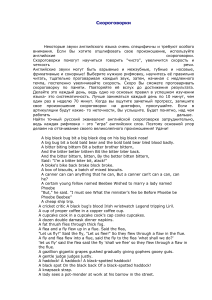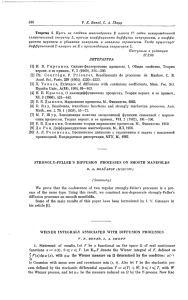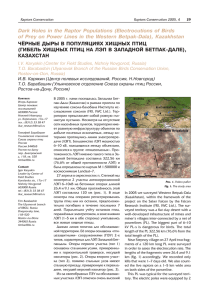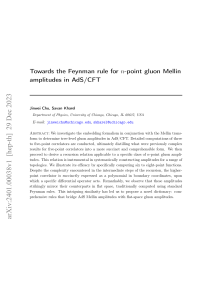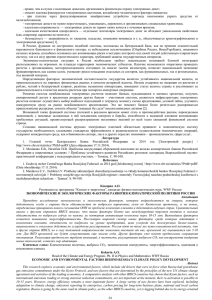Лекция I
реклама
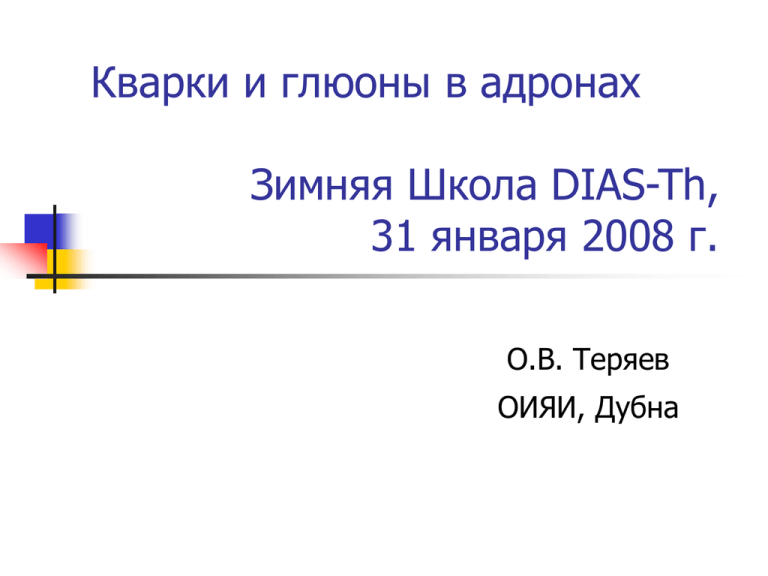
Кварки и глюоны в адронах Зимняя Школа DIAS-Th, 31 января 2008 г. О.В. Теряев ОИЯИ, Дубна Почему это важно? Все фундаментальные взаимодействия (известные и – пока? - нет) описываются на языке кварков и глюонов Наблюдаются только адроны – НЕОБЫЧНЫЕ связанные состояния конфайнмент - фундаментальная математическая проблема (“Millenium problems” – 1 M$ http://www.claymath.org/millennium/YangMills_Theory/) Почему это важно? - II Взаимодействие с адронами – существенный элемент поиска любой новой физики Адроны – протоны - легче ускорить и они сильно взаимодействуют позволяют получить высокую статистическую обеспеченность Непертурбативная КХД – ответственна почти за ВСЮ ВИДИМУЮ массу Вселенной План Партонная “модель” и КХД факторизация Эволюция партонных распределений Сложные жесткие процессы и “новые” партонные распределения Какая польза от асимптотической свободы, если есть конфайнмент? Эффективная константа мала, если велики импульсы (малы расстояния) Но адроны на массовой поверхности – малые квадраты импульсов Можно ли отделить большие расстояния от малых? Асимптотики амплитуд Инструмент – Импульсный интеграл – красивая топологическая интерпретация (БШ – 29.5) Фотонный пропагатор – лекции А.Г. Грозина Основа для жесткого процесса – электронпозитронной аннигиляции в адроны Электрон-позитронная аннигиляция в адроны Сохранение вероятности: Все кварки -> все адроны Удобно нормировать на сечение аннигиляции электрон-позитронной пары в мюон-антимюонную R Nc e q 2 q R-отношение Зависит от энергии: c-кварк: 2 ->10/3 А экспериментально? – 3 цвета и дробные заряды вполне видны (но…) Асимптотики амплитуд -II 2-х -> 4 –х хвостка Асимптотики амплитуд -III Большие кинематические переменные – малые параметры Электротехническая аналогия – большой ток -> короткое замыкание Глубоко неупругое рассеяние ep -> e’X Виртуальный лептон – пробник адронной структуры Амплитуда ГНР в координатном представлении - факторизация Адронные матричные элементы кварковых полей! Ряд Тейлора Факторизация - II Лоренц-инвариантность Моменты Вот и партонная модель От старых к новым Новые партонные распределения Малые x - непроинтегрированные Эксклюзивные жесткие процессы – обобщенные Поляризационные эффекты - спиновые Одиночные спиновые асимметрии – эффективные Одиночные спиновые асимметрии (ОСА) Необходимое условие (в Т-инвариантной теории) – интерференция амплитуд с фазовым сдвигом между ними КХД факторизация – фазы из жесткой и мягкой частей амплитуды а также из перекрытия этих частей (Обобщенная) оптическая теорема – фазы связаны со скачками по положительным кинематическим переменным (инвариантным массам) Жесткая часть : Теория возмущений (a la QED: Barut, Fronsdal (1960), недавно обнаружена в JLAB):Kane, Pumplin, Repko (78), А.В. Ефремов (78) Пертурбативные фазы в КХД Экспериментально – большие одиночные асимметрии RHIC (07) Корреляция жесткой и мягкой области – твист 3 Кварки – только из адронов Разные возможности для факторизации – сдвиг границы между жесткой и мягкой областями Новая возможность: Вместо of 1-петлевого Борновский твист 3: А.В. Ефремов, OT (85, Фермионные полюса – мягкие кварки); Qiu, Sterman (91, глюонные полюса – мягкие глюоны) Корреляторы ОСА из функции распределения D. Sivers (90) - корреляция спина протона и поперечного импульса кварка Откуда фаза?! – нет скачка по массе протона (протон стабилен). Но! Вклад твиста 3 (фаза есть) можно записать в виде эффективной функции распределения (Boer, Mulders, OT, 97), оказывающейся функцией Сиверса (Boer. Mulders, Pijlman, 2001) Что значит, что функция эффективная? Мягкие глюоны – низкоэнергетическая теорема жесткий подпроцесс похож на твист 2 (Ratcliffe, OT, 2007) с точностью до цветного фактора = цветного заряда партонов Простейшая форма эффективности – знак (Collins, 2002) Процессы с большим PT Цветные факторы – отличаются для фрагментации из кварков и глюонов Адронные процессы – разные факторы для разных диаграмм - нетривиальная калибровочнаф инвариантность Функция Сиверса в Полуинклюзивном ГНР Наблюдаемые асимметрии Извлечение функции Сиверса Адронные процессы – двухструйная азимутальная асимметрия – глюонная функция Сиверса Boer & Vogelsang (PRD 69, 094025 (2004)) proton spin y parton kTx x z What is “Leading” twist? Practical Definition - Not suppressed as M/Q However – More general definition: Twist 3 may be suppresses as M/P T .Twist 3 may contribute at leading order in 1/Q ! Does this happen indeed?? – Explicit calculation for the case when Q >> P T May be interesting for experimental studies Sources of Phases in SIDIS and Drell-Yan processes a) Born - no SSA b) -Sivers (can be only effective) -for both SIDIS and DY c) Perturbative d) Collins (SIDIS) or (effective) Boer (DY) Final Pion -> Photon: SIDIS -> SIDVCS (clean, easier than exclusive) - analog of DVCS Twist 3 partonic subprocesses for SIDVCS Real and virtual photons most clean tests of QCD Both initial and final – real :Efremov, O.T. (85) Initial – quark/gluon, final - real : Efremov, OT (86, fermionic poles); Qui, Sterman (91, GLUONIC poles) Initial - real, final-virtual (or quark/gluon) – Korotkiian, O.T. (94) Initial –virtual, final-real: O.T., Srednyak (05; smooth transition from fermionic via hard to GLUONIC poles). Quark-gluon correlators Non-perturbative NUCLEON structure – physically mean the quark scattering in external gluon field of the HADRON. Depend on TWO parton momentum fractions For small transverse momenta – quark momentum fractions are close to each other- gluonic pole; probed if : Q >> P T>> M p 2 x x 2 1 T Q 2 x z B Cross-sections at low transverse momenta: (14) - non-suppressed for large Q if Gluonic pole exists=effective Sivers function; spin-dependent looks like unpolarized (soft gluon) A p (x ) s m x q( x ) 2M B V T 2 T T B B sin s h Effective Sivers function Needs (soft) talk of large and short distances Complementary to gluonic exponential, when longitudinal (unsuppressed by Q, unphysical) gluons get the physical part due to transverse link (Belitsky, Ji, Yuan) We started instead with physical (suppressed as 1/Q) gluons, and eliminated the suppression for gluonic pole. Another support – Ji, Qiu, Vogelsang, Yuan in DY and SIDIS – PERTURBATIVE Sivers function from twist 3 Other way - NP Sivers and gluonic poles at large PT (P.G. Ratcliffe, OT, hep-ph/0703293 ) Sivers factorized (general!) expression Expand in kT = twist 3 part of Sivers From Sivers to twist 3 - II Angular average : As a result M in numerator - sign of twist 3. Higher moments – higher twists. KT dependent function – resummation of higher twists From Sivers to gluonic poles III Final step – kinematical identity Two terms are combined to one Key observation – exactly the form of Master Formula for gluonic poles (Koike et al, 2007) Non – Suppression as 1/Q seen! Effective Sivers function Follows the expression similar to BMT, BMP, JVY (1) x f S ( x ) Ci 1 T j ( x, x ), 2M Up to Colour Factors ! Defined by colour charge (natural for low energy theorems!): Collins sign rule: ISI -> FSI holds because of quark -> antiquark (cf. Abelian charge – Collins&Qiu (arXiv:0705.2141 ) What are these factors? SIDIS at large pT : -1/6 for mesons from quark, 3/2 from gluon fragmentation (kaons?) DY at large pT (PAX): 1/6 in quark antiquark annihilation, - 3/2 in gluon Compton subprocess – Collins sign rule more elaborate – involve crossing of distributions and fragmentations - special role of PION DY (COMPASS). Hadronic pion production – more complicated – studied for P-exponentials by Amsterdam group + VW FSI for pions from quark fragmentation -1/6 x (non-Abelian Compton) +1/8 x (Abelian Compton) How to pass from high to low PT Hard poles in correlators (become soft ay small PT – c.f. SIDVCS) Low pT – cannot distinguish fragmentation from quarks and gluons: 3/2-1/6 = 4/3 (Abelian) Strong transverse momentum dependence, very different for mesons from quark and gluon fragmentation Colour flow Quark at large PT:-1/6 Gluon at large PT : 3/2 Low PT – combination of quark and gluon: 4/3 (absorbed to definition of Sivers function) Similarity to colour transparency phenomenon Twist 3 factorization (Efremov, OT ’84, Ratcliffe,Qiu,Sterman) Convolution of soft (S) and hard (T) parts Vector and axial correlators: define hard process for both double (g 2 ) and single asymmetries Twist 3 factorization -II Non-local operators for quark-gluon correlators Symmetry properties (from Tinvariance) Twist-3 factorization -III Singularities Very different: for axial – Wandzura-Wilczek term due to intrinsic transverse momentum For vector-GLUONIC POLE (Qiu, Sterman ’91) – large distance background Sum rules EOM + n-independence (GI+rotational invariance) –relation to (genuine twist 3) DIS structure functions Sum rules -II To simplify – low moments Especially simple – if only gluonic pole kept: Gluonic poles and Sivers function Gluonic poles – effective Sivers functions-Hard and Soft parts talk, but SOFTLY Implies the sum rule for effective Sivers function x (soft=gluonic pole dominance assumed in 1 the whole allowed x’s region of quark-gluon 0 correlator) f T ( x) 2 dxx _ 1 1 T ( x, x ) ( x ) 2M 4 v 1 4 g 2 ( x) dxx 3 0 f T ( x)( 2 x) Compatibility of SSA and DIS Extractions of Sivers function: – “mirror” u and d First moment of EGMMS = 0.0072 (0.0042 – 0.014) Twist -3g - similar for neutron and proton (0.005) and of the same sign – nothing like mirror picture seen –but supported by colour ordering! Current status: Scale of Sivers function – seems to be reasonable, but flavor dependence differs qualitatively. Inclusion of pp data, global analysis including gluonic (=Sivers) and fermionic poles 2 Relation of Sivers function to GPDs Qualitatively similar to Anomalous Magnetic Moment (Brodsky et al) Quantification : weighted TM moment of Sivers PROPORTIONAL to GPD E x f ( x ) xE ( x ) (hep-ph/0612205 ): T Burkardt SR for Sivers functions is now related to Ji SR for E and, in turn, to Equivalence Principle dxx f q ,G T ( x) q ,G dxxE ( x ) 0 How gravity is coupled to nucleons? Current or constituent quark masses ?– neither! Energy momentum tensor - like electromagnertic current describes the coupling to photons Equivalence principle Newtonian – “Falling elevator” – well known and checked Post-Newtonian – gravity action on SPIN – known since 1962 (Kobzarev and Okun’) – not yet checked Anomalous gravitomagnetic moment iz ZERO or Classical and QUANTUM rotators behave in the SAME way Gravitational formfactors Conservation laws - zero Anomalous Gravitomagnetic Moment : (g=2) May be extracted from high-energy experiments/NPQCD calculations Describe the partition of angular momentum between quarks and gluons Describe interaction with both classical and TeV gravity – similar t-dependence to EM FF Electromagnetism vs Gravity Interaction – field vs metric deviation Static limit Mass as charge – equivalence principle Gravitomagnetism Gravitomagnetic field – action on spin – ½ from spin dragging twice smaller than EM Lorentz force – similar to EM case: factor ½ cancelled with 2 from Larmor frequency same as EM Orbital and Spin momenta dragging – the same - Equivalence principle Sivers function and Extended Equivalence principle Second moment of E – zero SEPARATELY for quarks and gluons –only in QCD beyond PT (OT, 2001) supported by lattice simulations etc.. -> Gluon Sivers function is small! (COMPASS, STAR, Brodsky&Gardner) BUT: gluon orbital momentum is NOT small: total – about 1/2, if small spin – large (longitudinal) orbital momentum Gluon Sivers function should result from twist 3 correlator of 3 gluons: remains to be proved! Generalization of Equivalence principle Various arguments: AGM 0 separately for quarks and gluons – most clear from the lattice (LHPC/SESAM, confirmed recently) CONCLUSIONS Sivers and other TMD functions contain infinite tower of twists starting from 3 – special role of moments Colour charge of initial/final partons crucial – NO factorization in _ naive sense (cf Abelian model g2 dx of Collins&Qiu) Transverse momentum dependence of Sivers SSA in SIDIS and DY (PAX) is a new sensitive test of QCD Relation of Sivers function to twist 3 in DIS: Reasonable magnitude, but problems with flavor dependence.Bochum results with suppressed singlet twist 3 supported! Relation of Sivers to GPD’s – link to Nucleon Spin and Equivalence Principle Problems: evolution (no WW for Sivers) and SR from twist 3. q ,G
